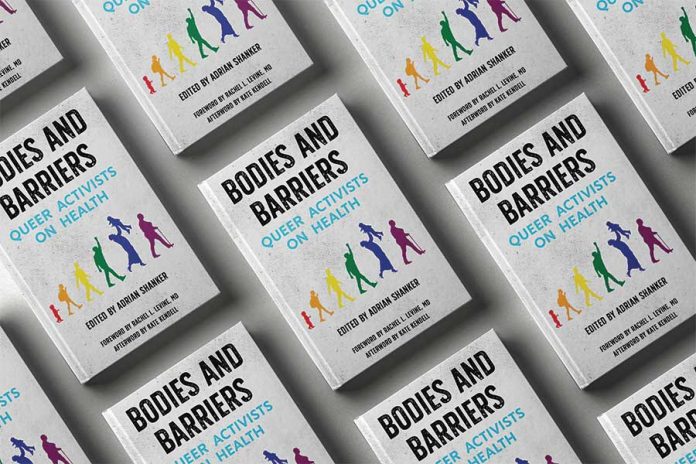The new anthology “Bodies and Barriers: Queer Activists on Health,” is an eye-opening and compassionate collection of essays addressing topics of importance to the LGBTQ community.
Edited by Adrian Shanker, founder and executive director of Allentown’s Bradbury-Sullivan LGBT Center, the volume raises awareness about health care issues — from how LGBTQ folks are mistreated and discriminated against by medical professionals to personal safety concerns.
The contributors are a mix of practitioners and activists who are concerned with health care both in Pennsylvania and nationally. The book is divided by age groups into four chapters, with topics ranging from pediatric care for transgender youth (a lovely section) to caregiving for seniors, as well as HIV stigmatization, suicide survival and other issues.
The early chapters identify the need for more inclusive sex education, allowing queer youth to feel less marginalized and less demonized. A lack of knowledge creates negative health scenarios, from rising HIV rates to depression and suicide. According to contributor Ryan Thoreson, LGBTQ teens have higher rates of alcohol, tobacco and other drug use.
The best entries in “Bodies and Barriers” are told in the first person. Preston Heldibridle writes about binding for transmasculine youth, recounting in detail his experiences with body dysphoria as well as the emotional and physical toll of being uncomfortable in his body. He describes the confidence he feels wearing a commercial binder and the importance of having and using the device properly. Moreover, he explains how medical professionals are not necessarily sensitive to trans patients and can provide misinformation, prompting most trans people to rely on each other for information and resources. This “mentoring” is especially valuable for people in rural areas who may have limited access to trans-friendly doctors.
The difficulties LGBTQ folks have with medical professionals is put in bold relief as transgender author and activist Laura Jacobs recounts feeling insulted and even fetishized — as well as pried for irrelevant information — when she saw a doctor about a sinus issue.
Such insensitivity is also the subject of Robyn Ochs’ excellent entry about bisexuals’ experiences with health care professionals. Ochs explains how poorly she has been treated in doctors’ offices and that she has been anxious about disclosing her sexual identity because of the reactions she has received. As she recounts numerous negative experiences from other bisexuals — such as assumptions that belittle and shame them to open hostility — Ochs also provides positive encounters from individuals who were treated with dignity and respect and the value and security that provides them.
A key theme that is universal to all of the entries in “Bodies and Barriers” is that the government, the medical establishment and even the pharmaceutical industry must become more caring, considerate and compassionate to achieve equity. The LGBTQ community has a higher risk for death by suicide and mental health conditions, a higher percentage of smokers, and more body dysphoria issues than their heterosexual peers. For example, according to Thoreson, trans youth can develop bladder infections simply because they are afraid to use school bathrooms.
Several contributors talk about risk factors, suggesting that members of the LGBTQ community need to be more vigilant about their health. Editor Adrian Shanker emphasizes that too few members of the queer community get anal Pap tests for cancer — or even know to ask for them. Most doctors, he writes, “do not think about this test for their patients.” He provides an essential discussion of this health concern and what is being done to increase awareness.
“Bodies and Barriers” also features contributions from local activists, such as Chris Bartlett, executive director of the William Way Community Center. Bartlett’s chapter discusses the Marielitos, LGBT Cubans who came to America on the Mariel Boatlift in 1980. (This was the subject of an exhibit he mounted). Arriving in Fort Indiantown Gap, Pennsylvania, many of these immigrants were infected with HIV and sought permanent housing along with citizenship. How older activists helped organize and support these refugees is inspiring.
The last section of the book focuses on the aging LGBTQ population and risk factors they face with social isolation. Kat Carrick and Ntlotleng Mabena write about rural lesbians who may not have easy access to healthcare and other needs. Likewise, Liz Bradbury’s essay on caregiving for LGBT older adults addresses the genuine concern of being an “elder orphan” — someone who has no family members to care for them. The closing chapter on bereavement ends the collection on a poignant note about how the grieving process can be especially difficult for LGBTQ folks.
“Bodies and Barriers” is an important collection that shares largely unheard voices and stories from the community. It should motivate LGBTQ folks to take their health care more seriously — and demand professionalism from the medical community. It is a valuable addition to the literature.

